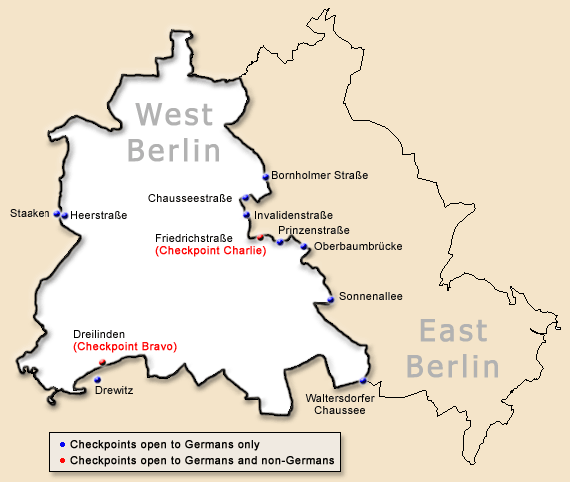 |
| Checkpoint Charlie 1963 |
The Cold War “BlackBox” is a temporary exhibition installed by the cash-strapped city government until a museum can be built there. Across the road is a fascinating panorama of the Berlin Wall by the German-Iranian artist Yadegar Asisi.
Christian Dalera news pick
It has taken 23 years for Berlin authorities to wake up to Checkpoint Charlie’s potential for tourism. The city sold the land there soon after German unification. Subsequent owners have gone bankrupt, abandoning the patch to hawkers of Soviet flags and fur military hats, doner kebabs, curried sausage and, of course, allegedly genuine pieces of the Berlin Wall.
“It was a mistake to sell the land here in the early 1990s,” Culture Secretary Andre Schmitz said at the opening of Asisi’s panorama. “We are now trying to make the best of it.”
Of Berlin’s 10 million visitors a year, 79 percent say 20th-century history is the main reason for their trip. Checkpoint Charlie is high on the must-see list: After all, World War III almost broke out here in 1961.
Dangerous Deadlock
Soviet and U.S. tanks, fully loaded and with orders to fire if fired upon, were locked in a standoff lasting hours across the border between East and West Berlin, about 100 yards (91 meters) apart. The deadlock ended when U.S. President John F. Kennedy and Soviet leader Nikita Khrushchev agreed to withdraw the tanks -- one-by-one, five yards at a time.
Checkpoint Charlie was the only crossing from East to West Berlin for diplomats and non-German visitors. The old Cafe Adler, once a hub of journalists and spies on the Western side of the border, is now part of a Berlin cafe chain. Just down Zimmerstrasse is a car-hire center offering ancient Trabants for nostalgic spins around the city.
Outside the Haus am Checkpoint Charlie, the only museum on the site until now, students pose as guards by a sign warning “YOU ARE NOW LEAVING THE AMERICAN SECTOR.” The privately run museum was founded in 1962 after the construction of the wall.
With its stories of daring and sometimes tragic escape attempts by East Germans to the West, it attracted 870,000 visitors in 2010, the latest year for which figures are available, making it the fourth-most visited museum in the city.
Death Strip
Asisi’s panorama should capture the imagination of tourists, especially those too young to have known the Berlin Wall first-hand. It’s probably the closest you can get to experiencing the real thing today. From a platform in the rotunda building visitors have a bird’s eye view over the wall on a rainy day in the 1980s.
From Kreuzberg in the West, they look out across the “death strip,” with its guard dogs, automatic machine guns and watch-towers, toward the dark, dilapidated houses of East Berlin, where just a few windows are warmly lit.
The strength of the panorama lies in its realistic portrayal of everyday life in the shadow of the wall; of how West Berliners learned to live with this monstrous symbol of repression on their doorstep.
Children play ball against it, a graffiti artist sprays a face on it, and a children’s farm, complete with horse and stable, thrives alongside it. The protest culture of alternative Kreuzberg -- then a haven for artists, squatters and young men escaping military service -- is illustrated through banners hanging from houses occupied to prevent their demolition.
Cozy Corner
The most ironic touch from today’s distanced perspective is a bar called “Gemuetliche Ecke” (Cozy Corner), situated just meters from the automatic machine guns and harsh lights of the death strip. Probably no one batted an eyelid at the name at the time -- a sign of how integrated the wall became in Berliners’ perception of their surroundings.
At the BlackBox across the road from the panorama, a jam- packed multimedia exhibition stretches from North Korea via Afghanistan to Cuba in its attempt to present the entire scope of the Cold War. It provides information on the other sites in Berlin where Cold War history is addressed.
On a shoestring budget of 330,000 euros ($387,000), its expected life-span is two years. After that, the city government wants to rent space in a complex planned by a group of Irish developers and establish a permanent Cold War museum.
Source: By Catherine Hickley for Bloomberg

About time Berlin realised the significance of Checkpoint Charlie as the global symbol for the Cold War.
ReplyDelete